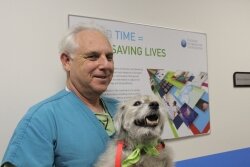Focused on a cure: Kassell's ultrasound vision
Every once in a while, a technology comes along that revolutionizes medicine. Sometimes, it just takes a while to recognize its impact. In 1970, for instance, Neal Kassell saw a CT scan for the first time.
"I thought it had no future," laughs the 67-year-old UVA neurosurgeon. "I was wrong."
Kassell was certain he was right, however, when, about eight years ago, he conceived of treating and even curing previously untreatable conditions using ultrasound technology.
"I've been doing research since 1962, and I finally had the Nobel Prize-winning idea," Kassell recalls with a smile. "I got home and went to the internet, and discovered it indeed is a Nobel Prize-winning idea– it just wasn't mine."
While the concept of ultrasound as a treatment tool already existed, no one had fully explored its seemingly endless applications. Kassell was up to the task.
After initially working to create a focused ultrasound center at UVA, Kassell says he felt the administration was moving too slowly, and he took matters into his own hands, founding the Focused Ultrasound Foundation as a way to raise money for research.
"It didn't take two weeks to appreciate that we had this organization that could benefit UVA and that there was no reason it couldn't benefit the whole field on a global scale," says Kassell, noting that the foundation soon helped create the Focused Ultrasound Center at UVA and is in the process of opening a second such "center of excellence" in London.
Six-and-a-half years after the foundation's launch– and some $40 million in funds raised later– the implications are staggering as Kassell ticks off a list of dozens of ailments, including breast cancer, essential tremor– a Parkinson's-like illness– and previously inoperable brain tumors that may soon be treated with focused ultrasound, eliminating the need for surgery and use of radiation in certain cancer cases.
The possibilities seem endless and complex, but the technology itself is essentially simple.
"Ultrasound is harmless," Kassell explains, using the analogy of a magnifying glass focusing beams of light to burn a hole in a leaf. The difference is that ultrasound uses sound "beams."
"In targeted ultrasound," he says, "many beams are focused on a point deep inside the body. Where each individual beam goes through tissue, it has no effect, but at the focal point, there's a series of profound effects" as the beams converge and destroy damaged tissue or tumors without the need for cutting or damaging healthy tissue. Researchers are also working to develop microscopic capsules of drugs that will circulate throughout the body but be released only when the ultrasound beams hit them at a target location, enabling, for instance, the delivery of chemotherapy directly to a tumor.
If the treatment itself is focused, so is the Charlottesville-headquartered foundation, which boasts a board of some of the most prominent names in the field of medical innovation, including Johns Hopkins Medicine CEO Edward Miller, former FDA Commissioner Andrew von Eschenbach, and Philips Healthcare CEO Steve Rusckowski.
"We only fund things that we believe have the potential to result in commercially successful products in the marketplace that will help large numbers of patients," says Kassell, who hopes to raise an additional $25 million in the next several years and believes the foundation offers a unique opportunity to venture philanthropists.
"There are always opportunities to donate to good causes," he says, "But the opportunities to use philanthropic money to directly improve lives of millions of people comes along once in a generation."
Dr. Kassell will speak at The Haven at 5pm on Saturday, April 13, as part of the Tom Tom Founders Festival "Tom Talks."
